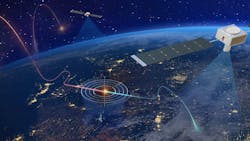Northrop Grumman to develop missile-defense prototype satellite sensor to detect, track hypersonic missiles
SCHRIEVER AIR FORCE BASE, Colo. – U.S. missile-defense experts are asking Northrop Grumman Corp. to develop a prototype satellite sensor to detect and track inbound enemy ballistic and hypersonic missiles.
Officials of the U.S. Missile Defense Agency (MDA) at Schriever Air Force Base, Colo., announced a $155 million contract Friday to the Northrop Grumman Aeronautics Systems segment in Redondo Beach, Calif., for the Hypersonic and Ballistic Tracking Space Sensor (HBTSS) Phase IIA effort.
HBTSS seeks to develop satellites for low-Earth orbit to provide global sensor coverage to detect, track, and target ballistic and hypersonic missiles.
Northrop Grumman engineers will provide on-orbit prototype demonstration of HBTSS capability, culminating with launch and early orbit testing.
HBTSS is to detect, track, and discriminate among missile targets, and ultimately will fold into the planned sensor infrastructure of the Space Development Agency’s (SDA) missile tracking layer, which will consist of hundreds of satellites in low Earth orbit that communicate with each other and work together to detect and track enemy weapons.
HBTSS satellites will have wide-field-of-view sensors networked together with optical inter-satellite cross-links to detect and track targets on land, at sea, in the air, and in space.
The HBTSS will be one of dozens of satellites with medium-field-of-view sensors that will provide fire-control data to missile defense systems to intercept incoming hypersonic and ballistic missiles.
Combining wide- and medium-field-of-view sensors is necessary to track hypersonic missiles like the Russian Avangard and Chinese Starry Sky-2 hypersonic glide vehicles (HGVs), which maneuver and travel around and through coverage areas of terrestrial radars and sensors.
Today's missile-defense systems are not able to track and kill hypersonic weapons, which are designed to outmaneuver contemporary detection systems through speed and hyper-maneuverability. In October 2019 MDA chose Northrop Grumman, Raytheon, Leidos, and L3Harris, each to design a prototype sensor payload. U.S. military commanders expect to launch the first HBTSS satellites in 2023.
On this contract Northrop Grumman will do the work in Redondo Beach, Calif., and should be finished by July 2023. For more information contact Northrop Grumman Aeronautics Systems online at www.northropgrumman.com.
About the Author
John Keller
Editor-in-Chief
John Keller is the Editor-in-Chief, Military & Aerospace Electronics Magazine--provides extensive coverage and analysis of enabling electronics and optoelectronic technologies in military, space and commercial aviation applications. John has been a member of the Military & Aerospace Electronics staff since 1989 and chief editor since 1995.
